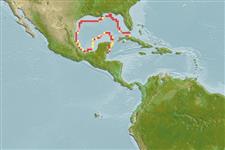Environment: milieu / climate zone / depth range / distribution range
Ökologie
seewasser bathydemersal; tiefenbereich 425 - 472 m (Ref. 28767). Deep-water; 30°N - 18°N, 98°W - 81°W
Western Central Atlantic: Gulf of Mexico.
Size / Gewicht / Alter
Maturity: Lm ? range ? - ? cm
Max length : 40.0 cm TL Männchen/unbestimmt; (Ref. 6902)
Kurzbeschreibung
Morphologie | Morphometrie
Leaf-like expansion of snout. Skin naked. Pelvic fins are leg like. No dorsal fins. Upper surface ash gray, lower surface pale grayish white, outer posterior belt of pectorals sooty gray, snout narrowly and irregularly edged with black, tail sooty at base (Ref. 6902).
Life cycle and mating behavior
Geschlechtsreife | Fortpflanzung | Ablaichen | Eier | Fecundity | Larven
Distinct pairing with embrace (Ref. 205).
Last, P.R., S. Weigmann and L. Yang, 2016. Changes to the nomenclature of the skates (Chondrichthyes: Rajiformes). In: Last and Yearsley (eds.). Rays of the World: Supplementary Information. CSIRO Special Publication. 11-34. (Ref. 118749)
IUCN Rote Liste Status (Ref. 130435)
Bedrohung für Menschen
Harmless
Nutzung durch Menschen
Mehr Information
Alter/GrößeWachstumLänge-GewichtLänge-LängeLängenhäufigkeitenMorphometrieMorphologieLarvenLarven Pop.Dyn.RekrutierungDichteBRUVS
ReferenzenAquakulturAquakultur ProfilZuchtlinienGenetikElectrophoresesVererbbarkeitKrankheitenVerarbeitungNutrientsMass conversion
PartnerBilderStamps, Coins Misc.LauteCiguateraGeschwindigkeitSchwimmstilKiemenoberflächeOtolithsGehirngrößeSehfähigkeit
Tools
Zusatzinformationen
Download XML
Internet Quellen
Estimates based on models
Preferred temperature (Ref.
123201): 8.6 - 12.8, mean 10 °C (based on 7 cells).
Phylogenetic diversity index (Ref.
82804): PD
50 = 0.7500 [Uniqueness, from 0.5 = low to 2.0 = high].
Bayesian length-weight: a=0.01000 (0.00244 - 0.04107), b=3.04 (2.81 - 3.27), in cm total length, based on all LWR estimates for this body shape (Ref.
93245).
Trophic level (Ref.
69278): 3.7 ±0.6 se; based on size and trophs of closest relatives
Widerstandsfähigkeit (Ref.
120179): niedrig, Verdopplung der Population dauert 4,5 - 14 Jahre. (Assuming fecundity<100).
Fishing Vulnerability (Ref.
59153): Low to moderate vulnerability (30 of 100).
